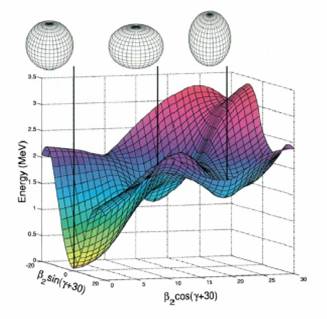
| Nuclear Physics Group |
Physics Department
Conferences
Seminars
Useful Links
IT Resources
Feedback:
support@ns.ph.liv.ac.uk
Shape Coexistence

The ground states of lead nuclei are spherical because they contain 82 protons, which is a "magic number" analogous to the closed electron shells of noble gases. However, in very proton-rich lead nuclei, pairs of protons can be more easily excited into levels above the shell gap to produce oblate and prolate configurations that coexist at low excitation energies close to the spherical ground states. Liverpool is leading experiments to identify and study the interplay between these coexisting structures in lead isotopes, as well as in neighbouring elements from osmium to polonium where two of the shapes (oblate and prolate) are found. One of the most spectacular cases is the triple shape coexistence in the neutron-deficient even-mass Pb isotopes. One of the best studied cases to date is 186Pb, where three differently shaped 0+ states have been observed in our recent alpha-decay study of 190Po at the velocity filter SHIP, carried out at GSI Darmstadt. The Liverpool group is spearheading programmes of in-beam and decay measurements at Jyväskylä using target arrays such as SACRED and JUROGAM used in conjunction with RITU. These measurements will shortly employ the focal plane spectrometer GREAT being designed and constructed by a Liverpool-led collaboration. The group is also pioneering the isomer decay spectroscopy of nuclear fragments separated using the FRS at GSI in a campaign that is preparing the ground for the RISING project. Another new programme of research exploits the radioactive beams from ISOLDE at CERN. |
| © University of Liverpool | Disclaimer. | |